Homemade Tagliatelle
Homemade tagliatelle pasta is long, slender, flat, and a much-loved pasta shape. For good reason! It works with a range of sauces and if you have flour, eggs, olive oil, and salt you can make it immediately.
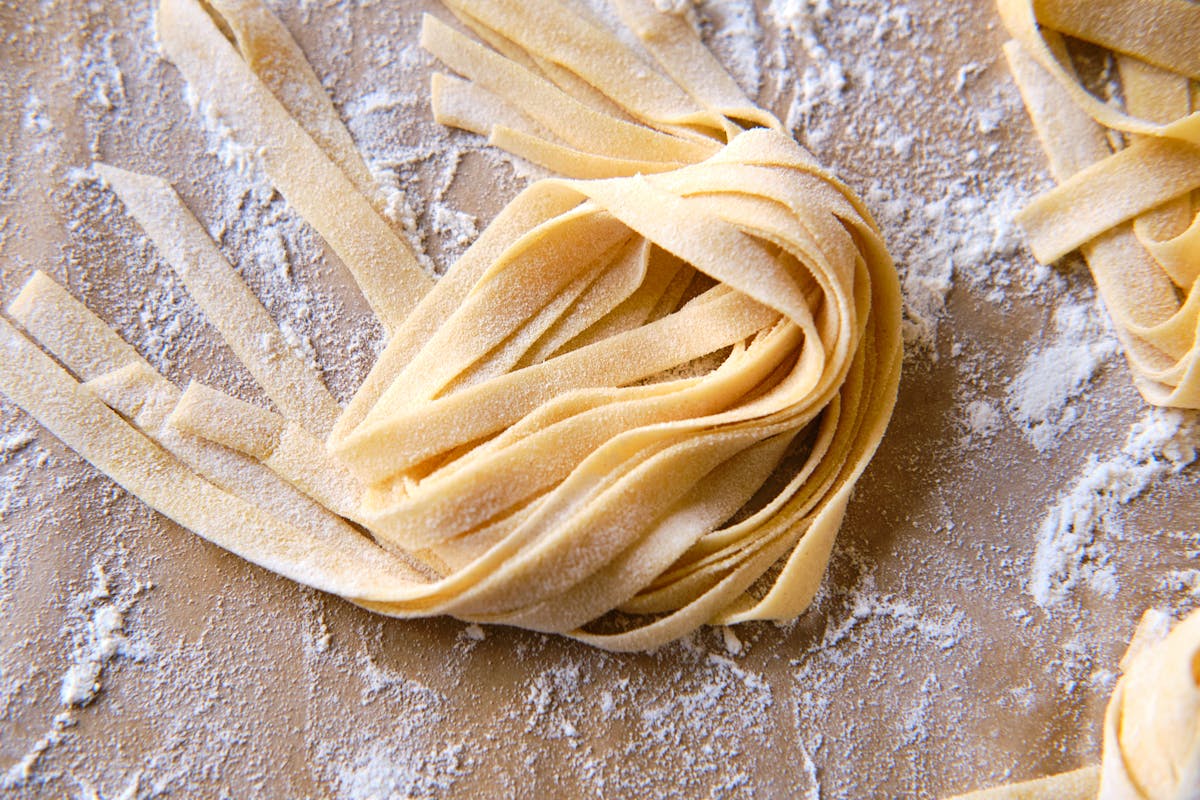
It's time to tackle another pasta shape! Tagliatelle is a wonderful pasta originating in Bologna. For reference, it’s typically much less wide than pappardelle, less wide than fettuccine as well. I love the lightness of tagliatelle in comparison, and tend to go rogue with how I serve it. A bowl of homemade tagliatelle is special and in this post I’m going to talk through the process of making the pasta, and then we’ll talk about some favorite ways to enjoy it.
About this Tagliatelle Recipe
Similar to pappardelle, when you enjoy tagliatelle in a restaurant the ratio of eggs to flour is often much, much higher than what I make at home. With the former, the weight of egg yolks can equal the weight of the flour. That means, you might need nearly two dozen yolks for the amount of flour we're going to use today. This version is going to use some eggs, but nothing extreme.
For home-style tagliatelle, I use 4 eggs for 400g of flour. It ends up being more egg-y than this basic homemade pasta recipe, but it works great, I usually have the ingredients on hand, and it's perfect for everyday cooking and eating.
How Wide Should Tagliatelle Pasta Be?
The question of the day is, how wide should tagliatelle be? It is a popular packaged, dried pasta shape, but the width varies between brands, so that isn’t much help. I was always a bit stumped until I learned of the existence of a golden tagliatella (the singular of tagliatelle). This, btw, is one of my favorite Italian stories. Bologna’s Chamber of Commerce keeps a single, gold, tagliatella on hand as a reference. It is in a wood box, and you can apparently view it by appointment. So, if you’re going by the literal gold standard, aim for 7mm uncooked. And, as far as I’m concerned, if you’re going to make a pasta shape in solid gold, you get the final word.
Which Flour Should I Use?
The tagliatelle you see pictured above was made with unbleached all-purpose flour. I typically use “00” flour, but came up short. “00” is powder-fine and made with low gluten, soft wheat flour. It’s wonderful for an egg pasta dough like this. But, as in this case, if you don’t have “00” you can certainly use all-purpose flour. I’ve also had success (referring to notebook) using 260g unbleached all-purpose flour and 140g einkorn flour. And, if you want to incorporate whole wheat flour start with 70g or so and build up from there to your liking.
How To Make Tagliatelle Dough By Hand
This is covered in the recipe below, but I wanted to include some step-by-step information and photos in case you find yourself confused.
Start by making a mound of the flour directly on the countertop. Make a deep crater in the top and add the eggs, olive oil, and salt.
Use a fork to break up the eggs without breaking through the walls of your flour mound. You want to try to keep the eggs contained, but if they break through, don’t worry - use a spatula or bench scraper to scoop them back in. Work more and more flour into the eggs a bit at a time. Drizzle 2 tablespoons of cold water across the mixture and keep mixing until you’ve got a dough coming together.
If you’re exclusively using all-purpose flour, you might not need more water. Other flours can be a bit thirstier, you can drizzle a bit water as you go if you feel like your dough is too dry. It should look like the pictures, you want to avoid having a wet dough. With some of the other flours I typically end up using 4-5 tablespoons of water total.
As I’ve mentioned in other pasta posts, I’ve found that a spray bottle is my favorite way to add water to pasta dough without adding too much. That said, drizzling works too. Use your hands to bring the dough together into a ball and knead for 7-10 minutes, until the dough is silky smooth and elastic. Now it goes into a bag to rest for a few minutes.
How to Roll and Cut Fresh Tagliatelle by Hand
If you don’t have a pasta machine, this is how to roll out tagliatelle dough by hand. Make sure your dough is at room temperature. Cut the dough into four equal pieces. Choose one piece to work with, and immediately wrap the rest so they don’t dry out. You'll need a floured work surface, and you'll want to keep the pasta floured a bit as well, so it doesn't stick to itself. If the dough is sticking, rub with a bit more flour. Move it around a bunch. Use a rolling pin to roll the dough out to your desired thickness. I tend to go thinner than I think I’ll want because the pasta swells a bit as it cooks. Ideally, you can get it thin enough to read a paper through the pasta sheet.
Once the dough is in a flat sheet, carefully roll the sheet like you’re rolling up a poster. Cut the dough into strips 7mm wide, that’s about 1/4-inch. 
Transfer the cut pasta to a floured baking sheet, toss with a bit more flour, and swirl into little nests. Repeat with the remaining dough. At this point you can cook the pasta immediately, dry it, refrigerate it, or freeze it.
How to Roll and Cut Fresh Tagliatelle by Machine
For tagliatelle I typically use a hybrid method. I use my manual pasta machine to create the thin pasta sheets. I then cut the pasta into tagliatelle by hand. Here’s the step-by-step: If your dough was refrigerated, bring it to room temperature before rolling out. Sprinkle a baking sheet generously with flour and aside. When you’re ready to roll out the pasta, cut it into six equal pieces. Squish one of them flat-ish with your fingers. Re-wrap the remaining dough immediately so it doesn’t dry out. Feed your flattened wedge through the pasta machine on its widest setting. Run it through 2 or 3 times. You want to get it into a rectangular shape if possible. Fold the dough in thirds so you have a long rectangle. Feed it through the pasta maker 2-3 more times on the widest setting. 
Continue to feed the pasta dough through the pasta maker, decreasing the width as you go. I run the pasta through a 2-3 times on each width, and dust with a bit of flour on both sides if I’m getting any stickiness. I typically roll tagliatelle out to the 6 setting on my Atlas 150. 
Related, I love my Altas hand-cranked pasta machine, and I've used it forever. They're relatively inexpensive, and a great investment if you think you might want to make homemade pasta more often. I hand cut the tagliatelle once I’ve made pasta sheets because the closest shape included with my machine is fettuccine I've also had great success using the pasta attachment to the Kitchen-Aid. So, if you already have one of those, consider the attachment.
Now that you have your pasta sheets, proceed back to the hand-cutting instructions. Cut the sheets into strips roughly 7mm thick. My pro-tip here is to cut more narrow than you think you should. My first few sheets of tagliatelle always turn wider than I intend. It’s a fight I fight every time with this pasta for some reason. Transfer the cut pasta to a floured baking sheet, toss the pasta with a bit of flour, and swirl the pasta into little nests. At this point you can cook the pasta immediately, dry it, refrigerate it, or freeze it.
The tagliatelle are lightly dusted and then shaped into nests that you can use immediately, or freeze to use at a later time. 
How To Freeze Tagliatelle
Freezing is my preferred method of storing any tagliatelle I’m not cooking immediately. Arrange freshly made, well floured, uncooked nests of tagliatelle across a floured baking sheet. Freeze for a couple of hours, and then transfer to double layer plastic bags. You can freeze for up to a couple of months. And you can cook straight from the freezer. No need to thaw, just dump the pasta into boiling salted water, and increase the cooking time a bit.
What To Serve With Tagliatelle
Tagliatelle might be traditionally served with one of a range of sauces - a Bolognese meat ragù or cream sauce, but with the exception of serving it with a favorite mushroom ragù, I tend to keep things on the lighter side with this pasta shape. Some examples:
- Spicy Tagliatelle: We had this for lunch today, pictured below. Tagliatelle tossed with a quick chile-flecked, strong citrus juice and soy sauce dressing. Loaded up with lots of roasted mushrooms, with mint, cilantro, and green onions. So good!

- Simple Tagliatelle with Lemon and Parmesan: Toss cooked tagliatelle along with a couple splashes of pasta water with a few tablespoons of butter or olive oil (whatever your preference). Add the zest of a couple lemons or oranges and a big squeeze of the juice. Shower generously with freshly grated Parmesan and finish with lots of black pepper and fresh chives.
- Tagliatelle with Caramelized Lemons: Colu Henry has a brilliant tagliatelle recipe in Back Pocket Pasta where she uses olives, arugula, garlic and caramelized lemons. It’s an easy fave.
- Mushroom Tagliatelle: Toss freshly cooked tagliatelle with a good splash of pasta water and plenty of this mushroom ragu.
- Tagliatelle with Simple Red Sauce: I’m also a fan of keeping it red and simple sometimes. This five-minute tomato sauce with some fresh basil leaves, and a bit of lemon zest to finish things off is all you need.
Variations on the Tagliatelle Dough
You can see in some of my other pasta recipes how to tweak basic tagliatelle pasta dough by adding different seasonings, juices, purees (in place of the water), and spices. For example, I added black pepper and turmeric to this sunny-looking cavatelli. And beet juice to electrify this fettuccini.
More Ideas!
Making fresh pasta is one of my favorite things to do. It's even better when you have others around to help, taking turns in shifts. I did a basic primer on making homemade pasta a while ago, if you love fettuccine noodles or anything along those lines, start there. You can also try making gnocchi (it's perfect with this pesto), or a favorite simple tomato sauce. And all my pasta recipes live here. Have a blast and enjoy!
More Pasta Recipes
- Mushroom Lasagna
- Pappardelle
- Cavatelli
- Pici
- Beet Fettuccine
- Pasta with Crushed Creamy Walnut Sauce
- Stuffed Shells
- Baked Ziti
- Harissa Spaghetti
- Penne alla Vodka
- more pasta recipes
Favorite Pasta Sauces
Other Favorite Italian Recipes
Homemade Tagliatelle
I've included a lot of detail about making this pasta shape in the main write-up. So if at any point you’re confused, have a look up there. Have fun!
- 3 1/4 cups / 400 g "00" flour or unbleached all-purpose flour
- 4 eggs / 200g eggs
- 1/4 teaspoon fine grain sea salt
- 1 tablespoon extra-virgin olive oil
- water (as needed)
-
Start by making a mound of the flour directly on the countertop. Make a deep crater in the top and add the eggs, salt, and olive oil. Use a fork to break up the eggs without breaking through the walls of the mound. You want to try to keep the eggs contained, but don’t worry if they break through - use a spatula or bench scraper to scoop them back in.
-
Work more and more flour into the eggs a bit at a time. Drizzle 2 tablespoons of cold water across the mixture and keep mixing until you’ve got a dough coming together. You can drizzle a bit more, a little at a time, as you go if you feel like your dough is too dry. It should look like the pictures up above, you want to avoid having a wet dough. I’ve found that a spray bottle is my favorite way to add water to pasta dough without adding too much. Use your hands to bring the dough together into a ball and knead for 7-10 minutes, until the dough is silky smooth and elastic.
-
Form the dough into a ball and place in a plastic bag, alternately, wrap in plastic wrap. Allow to rest for 30 minutes at room temperature. Use Immediately, or refrigerate for up to a day. You might be able to get away with two days, but the dough will start to discolor.
-
At this point either roll the pasta out thinly with a rolling pin or use a pasta machine (pictured above). There are more detailed instructions on how to do this in the main post up above. I typically roll tagliatelle out to the 6 setting on my Atlas 150 pasta machine. If your dough was refrigerated, bring it to room temperature before rolling out.
-
For tagliatelle I like to roll out all my sheets of pasta first, then cut them into strips 7mm wide. I use one of my thinner chopsticks as a reference and eyeball it. Transfer the cut pasta to a floured baking sheet, toss with a bit of flour, and swirl into nests. Flour enough that the pasta won’t stick later if that is the plan.
-
At this point you can cook the pasta immediately, dry it, refrigerate it, or freeze it.
-
Bring a large pot of salted water to a boil. Cook the pasta for 2-3 minutes, or until tender. Drain, reserving 3/4 cup of the pasta water in case you any for serving.
-
Serve in any of the ways suggested above and enjoy immediately.
Serves 4-6.

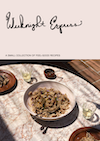
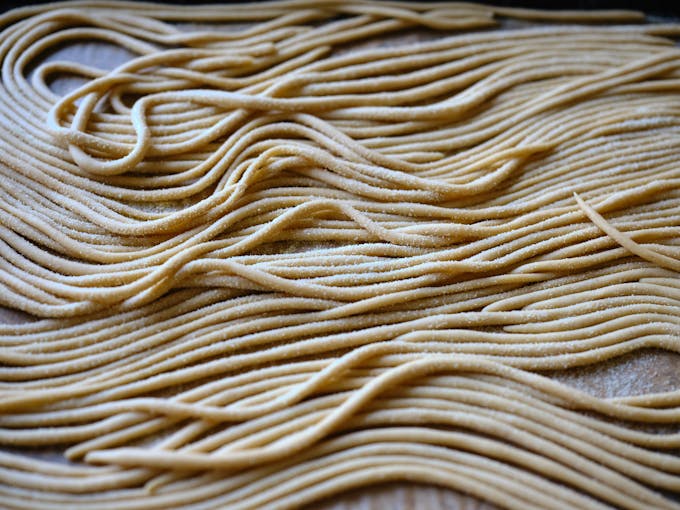
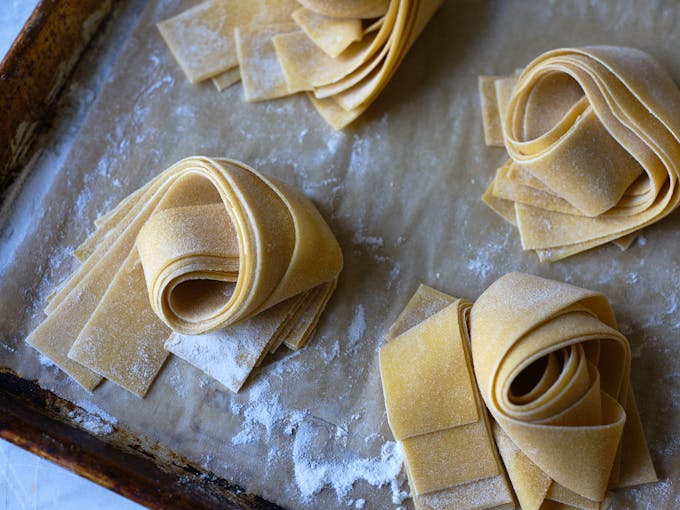
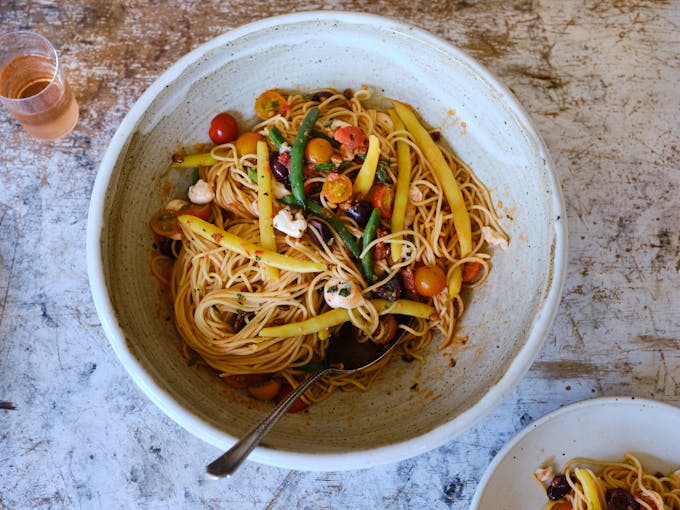
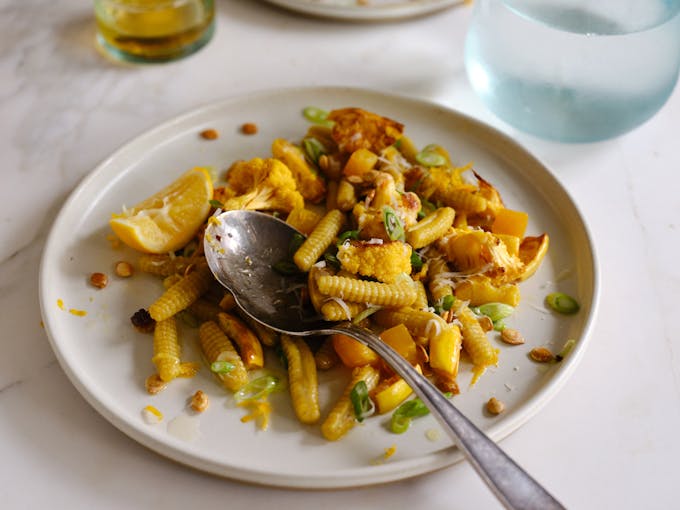

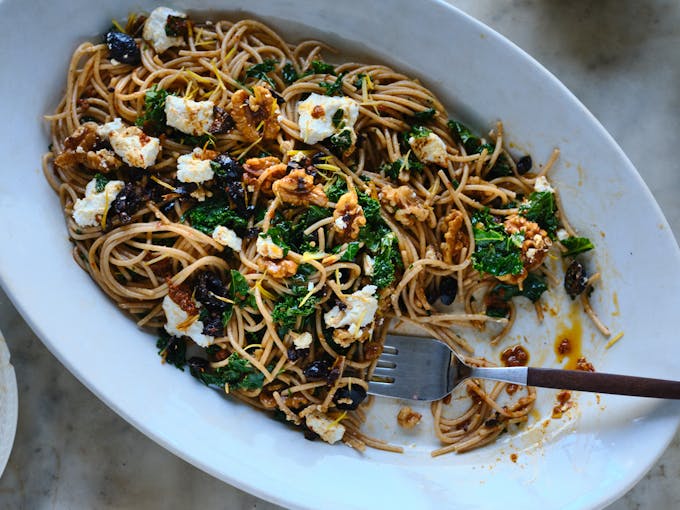

Post Your Comment